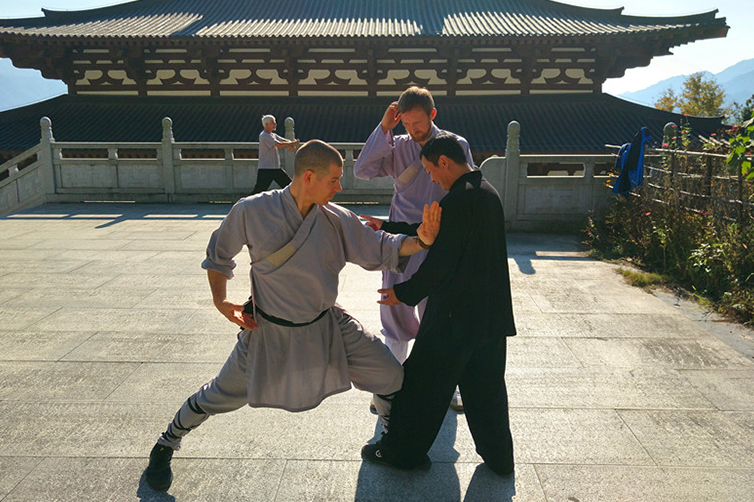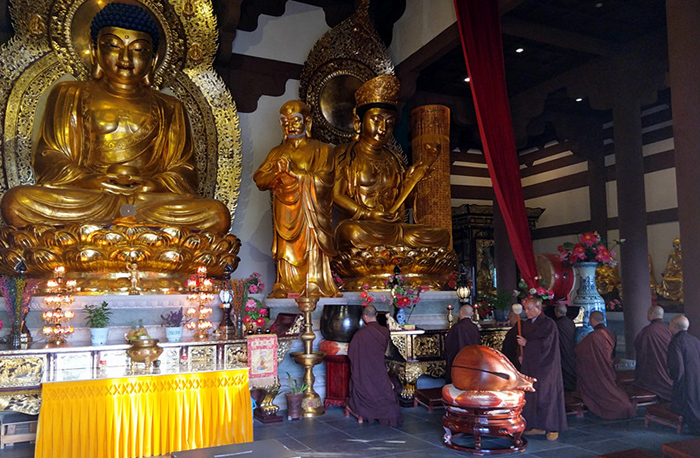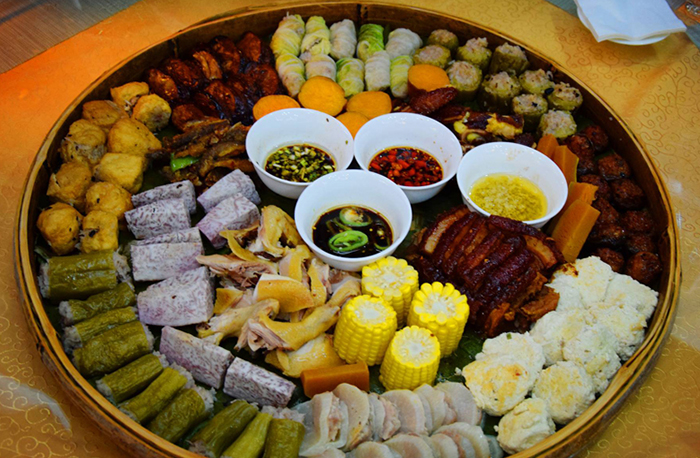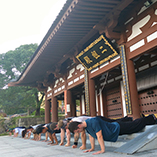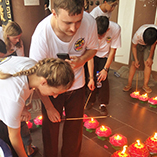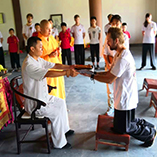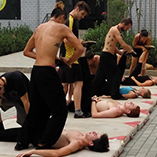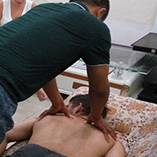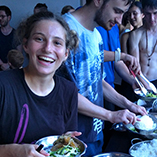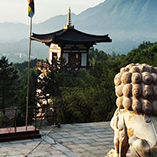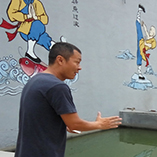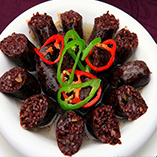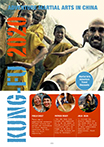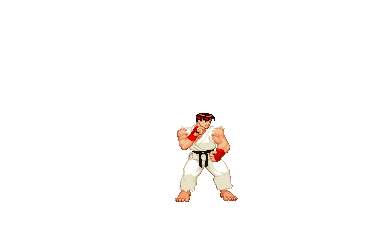Tai chi chuan or Taijiquan is an internal Chinese martial art using hard and soft techniques and represents the fusion of Yin and Yang applied to the human body. Most modern styles of tai chi trace their development to at least one of five traditional schools: Chen Style, Yang Style, Wu/Hao Style, Wu and Sun Style.
Tai chi chuan is generally classified as a soft internal style and its study primarily involves three aspects health, meditation and martial art.
Health: An unhealthy or otherwise uncomfortable person may find it difficult to meditate to a state of calmness or to use tai chi as a martial art. Tai chi's health training therefore concentrates on relieving the physical effects of stress on the body and mind. For those focused on tai chi's martial application, good physical fitness is still an important step towards effective self-defense.
Meditation: The focus and calmness cultivated by the meditative aspect of tai chi is seen as necessary in maintaining optimum health (in the sense of relieving stress and maintaining homeostasis) and in application of the form as a soft style martial art.
Martial art: The ability to use tai chi as a form of self-defense in combat is the test of a student's understanding of the art. Tai chi chuan martially is the study of appropriate changes in response to outside forces; the study of yielding and "sticking" to an incoming attack rather than attempting to meet it with opposing force.
Shaolin Boxing is the short form for 'Shaolin Temple Boxing Techniques'. As a means of spiritual discipline, Shaolin Boxing has been integrated in hundreds of schools, with Chan Buddhist influence or Zen guiding its presence. 'Shaolin boxing styles very greatly. There are in fact hundreds of different boxing styles. Students usually will practice general basics and then will devote him or herself to one or two boxing and weapon styles.
Shaolin Kung fu practice is generally talked about in terms of three realms.
1. In the primary realm, the practitioner practices their form and appearance.
2. In the intermediate realm, there is the integration of mind and fist, changing the tangible into the intangible, turning the law into the lawless; obeying no rules, having no movement to follow, controlling the enemy in the intangible. An ancient boxing manual reads, `defeat a person in the intangible or fail being seen`.
3. Shaolin Kungfu's highest realm is for all to be guided by the heart and to fight not just from form but from the formless.
Shaolin Buddhist practice is started in the mindful training of Kung Fu as it cultivates greater awareness. The purpose of learning Kung Fu no longer becomes the goal in itself, but is used as a means of awakening.
Features of Shaolin Kung Fu
1. Short but precise.
2. Box in a line.
3. Casual footwork.
4. Roll in and out.
5. Integration of mind and behavior.
6. Bending but actually not and straight but actually not.
7. Rise high in a tight form and drop in a spreading way. Rise to move with an intention of advance and drop to move with an intention of retreat.
8. Integration of Buddhism and boxing.
9. Focus on defense.
10. Combination of attacking and defending.
11. Numerous tricks.
12. Simple and practical.
13. Vigorous and strong.
14. Numerous acts shrinking back.
15. Numerous kicks.
16. Produce sounds.
Baji Quan, is a traditional Chinese Marital Arts that features explosive, short range power. It originated in Hebei Province in Northern China, but is also well-known in other places today, especially Taiwan. Also known as "rake fist" due to the fist being held loosely and slightly open when not striking, resembling a rake. The term baji signifies “an extension in all directions" and in this case, it means “including everything" or “the universe." 'Ba' (Chinese for eight) denotes the eight major points of the body: head, shoulders, elbows, hands, buttocks, kua, knees, and feet and 'Ji' (polar) is extended in the eight polar directions. Bajiquan shares roots with another Hebei martial art, Piguazhang. It is said that Wu Zhong, the oldest traceable lineage holder in the Bajiquan lineage, taught both arts together as an integrated fighting system. They split apart, only to be recombined by Li Shuwen in the late 18th to early 19th century. As a testament to the complementary nature of these two styles, there is a Chinese martial arts proverb that goes: "When pigua is added to baji, gods and demons will all be terrified. When baji is added to pigua, heroes will sigh knowing they are no match against it." Bajiquan is characterized by direct, culminating and powerful fast strikes that will render an opponent unable to continue and is used in close combat, giving attention to elbow, knee, shoulder and hip strikes. When blocking an attack or nearing an opponent, Bajiquan techniques emphasize striking major points of vulnerability, the thorax (trunk of the body), the legs and neck. The major purpose of Ba Ji training is to develop ultimate snapping power with each strike and open the opponent's arms forcibly (Qiang Kai Men) and mount attacks at high, mid, and low levels of the body, or San Pan Lian Ji.
Six Major Characteristic Powers:
1. Sinking (Xia Chen or Chen Zhui)
2. Thrusting (Chong)
3. Extending (Cheng)
4. Entangling (Chan)
5. Crossing (Shi Zi)
6. Explosive and short (Cun)
The six big ways of opening the door or Liu Da Kai: is the most important practice of Baji
1. Ding: using the fist, elbow or shoulder to push forward and upward.
2. Bao: putting arms together as if hugging someone. It is usually followed by chop (Pi).
3. Ti: elevating the knee to hit the thigh of the opponent, or elevating the foot to hit the shin of the opponent etc.
4. Dan: using a single move.
5. Kua: using the hip.
6. Chan: entanglement with rotation around the wrist, elbow and shoulder
Stepping and Body Methods:
Footwork in Baji Quan has three special features: Zhen Jiao, Nian Bu and Chuang Bu. These striking techniques relate to ancient Chinese medicine, which states that all parts of the body are connected, either physically or spiritually.
Open Hand Forms and Weapons:
The forms of Baji are divided into Fist (non-weapon) and Weapon forms. There are 20 fist forms, which include 12 Baji Small Structure Fists, Baji Black Tiger Fist, Baji Dan Zhai, Baji Dan Da/Dui Da, Baji Luo Han Gong, and Baji Si Lang Kuan. There are eight weapons forms, including Liu He Da Qiang (spear), Liu He Hua Qiang (spear), Chun Yang Jian (sword), San Yin Dao (sabre), Xing Zhe Bang (staff), Pudao, and Chun Qiu Da Dao (a long two-handed heavy blade, used by Generals sitting on their horses).
Some of Baji's forms:
Black Tiger Fist, Small Frame 4th Road, Single Plucking, Small Frame 5th Road, Small Frame 3rd Road, Small Frame 6th Road, LoHan (Buddha's Disciple) Work, Small Frame 1st Road, Small Frame 2nd Road, Six Big Openings- Liu Da Kai, Pu Dao Plain Knife, Spring Autumn Big Knife, 6 Harmony Big Spear, Single Strike, Railing Hand Partner Set- Fu Shou, Si Lang Kuan, Pure Yang Sword, Raise the Willow Saber, Travelling Staff, Six Harmony Spear.
Qigong, qi gong, chi kung, or chi gung (simplified Chinese: 气功; traditional Chinese: 氣功; pinyin: qìgōng; Wade–Giles: chi gong; literally: "Life Energy Cultivation") is a holistic system of coordinated body posture and movement, breathing, and meditation used for health, spirituality, and martial arts training. With roots in Chinese medicine, philosophy, and martial arts, qigong is traditionally viewed as a practice to cultivate and balance qi (chi) or what has been translated as "life energy".[1]
According to Daoist, Buddhist, and Confucian philosophy, respectively, qigong allows access to higher realms of awareness, awakens one's "true nature", and helps develop human potential.[2]
Qigong practice typically involves moving meditation, coordinating slow flowing movement, deep rhythmic breathing, and calm meditative state of mind. Qigong is now practiced throughout China and worldwide for recreation, exercise and relaxation, preventive medicine and self-healing, alternative medicine, meditation and self-cultivation, and training for martial arts.
Qigong, qi gong, chi kung, or chi gung (simplified Chinese: 气功; traditional Chinese: 氣功; pinyin: qìgōng; Wade–Giles: chi gong; literally: "Life Energy Cultivation") is a holistic system of coordinated body posture and movement, breathing, and meditation used for health, spirituality, and martial arts training. With roots in Chinese medicine, philosophy, and martial arts, qigong is traditionally viewed as a practice to cultivate and balance qi (chi) or what has been translated as "life energy".[1]
According to Daoist, Buddhist, and Confucian philosophy, respectively, qigong allows access to higher realms of awareness, awakens one's "true nature", and helps develop human potential.[2]
Qigong practice typically involves moving meditation, coordinating slow flowing movement, deep rhythmic breathing, and calm meditative state of mind. Qigong is now practiced throughout China and worldwide for recreation, exercise and relaxation, preventive medicine and self-healing, alternative medicine, meditation and self-cultivation, and training for martial arts.
https://en.wikipedia.org/wiki/Qigong
Qigong (or ch'i kung) refers to a wide variety of traditional cultivation practices that involve methods of accumulating, circulating, and working with qi, within the body. Qigong is practiced for health maintenance purposes, as a therapeutic intervention, as a medical profession, a spiritual path and/or component of Chinese martial arts.
The qi in qigong means air in Chinese, and, by extension, life force, dynamic energy or even cosmic breath. Gong means work applied to a discipline or the resultant level of skill, so qigong is thus breath work or energy work.
Qigong is an essential element of Chinese martial arts, traditional Chinese Medicine and Spirituality. The manipulation of this energy has both martial, healing and spiritual applications. In the marital arts qigong training is energy training in order to protect the body and or to develop internal force for combat. For this breath, movement and intent combine to direct qi flow.
The martial application of qigong began with the understanding of qi circulation and acupuncture. This was increased significantly when Da Mo’s Wai Dan exercises were introduced at the Shaolin Temple in 536 A.D. Although Da Mo’s Wai Dan exercises had been conceived for heath purposes the dangers of the time meant that it was not long before the monks discovered that the exercises derived from Da Mo’ Muscle/Tendon Changing Classic could greatly increase the strength and efficiency of the their muscles and also allowed them to direct the qi to resist blows. From then on it was researched and developed to improve martial arts as well as health. The theory was simple with the monks training they where able to use their minds to lead the qi to the muscles so energizing them so that they function more efficiently. If the average person generally uses his muscles at under 40% maximum efficiency with training he should be able to use his intent to lead qi to the muscles more effectively and so increase fighting effectiveness.
It was quickly reasoned that if balanced qi was required for life and well being then disturbing or stopping that flow would cause harm. It was discovered that the acupuncture cavities where ideal targets for pressing, grabbing, kicking or striking techniques. To make these strikes more affective hands, fingers where conditioned and methods for penetration where created.
The distinction between hard and soft qigong in many ways is similar to the distinction between hard and soft martial arts; in both cases the hard style is more external, focusing on external strength and power, whereas the soft style focuses on the flow of energy within the body. Hard qigong focuses on the strengthening of the muscles and tendons, leading 'guardian qi', or wei qi, to the skin to protect the body (as in Iron Shirt training / Shaolin Steel Jacket), and other external manifestations of qi. Although many forms of hard qigong have beneficial effects for the health this style can result in energy dispersion problems i.e. overdeveloped muscles. This is often why there is a progression from Wai Dan Qigong (external) to Nei Dan (internal) hard styles to soft styles and internal styles that move from soft to hard. In this way harmonious qi flow and usage is promoted for martial arts, health, vitality and longevity.
The Benefits of Qigong include:
1. Curing illness and promoting health.
2. Enhancing vitality and developing internal force.
3. Promoting youthfulness and longevity.
4. Expanding the mind and the intellect.
5. Spiritual cultivation.
Wing Chun (Chinese: 詠春; pinyin: yǒng chūn; Jyutping: wing6 ceon1; literally: "spring chant"), also romanisedas Ving Tsun or Wing Tsun, (and sometimes substituted with the characters 永春 "eternal springtime"[4]); is a concept-based Chinese martial art and form of self-defense utilising both striking and grappling while specialising in close-range combat.
The alternative characters 永春 "eternal spring" are also associated with some other southern Chinese martial arts, including Weng Chun Kung Fu and Yong Chun .[5][6]
https://en.wikipedia.org/wiki/Wing_Chun
